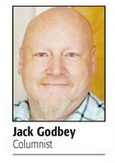Coffee with Mimi: Etiquette exists for reasons
Published 6:33 am Saturday, June 2, 2018
So, I will admit it — I did watch the royal wedding. I am an early-riser anyway and woke up just in time for the procession of the cars to the church. There were many reasons why I felt compelled to watch.
Among others, I have been to Windsor, a quaint little town attached to a magnificent royal home which figures in momentous British historical events.
I hoped for a glimpse of places I remembered; the sidewalk cafe where we had lunch just outside the walls, the long walk up to the castle, the little shops along the ancient, narrow village streets.
The wedding went off without a hitch. The improbably well-behaved, miniature wedding attendants were charming and performed their duties which were to be charming and well behaved. The two oldest boys carried off their special task of guiding the delicate and show stopper veil down the long, long aisle to lay it perfectly behind the bride at the altar.
We were in the business of weddings for many years. A wedding is often the first occasion the two individuals involved will be seen as a committed unit. It is also an event in which all those involved will be expected to take on assigned roles and accept their places. Many details will need to be considered. It is often overwhelming for a couple.
Confident, self-assured, successful young couples often exhibited fraying nerves as they waded through the weeks and months of planning. Quirky family issues and relationships would rear their long subdued heads at the most inopportune moment. The wedding day is a snapshot of what has gone before and the hopes for the future. There is a lot riding on these symbolic moments.
The newly minted Duke and Duchess of Sussex had plenty assistance to guide them through the minefields of their wedding. It isn’t hard to imagine there were battalions of staff assigned to the duty, each with their own detail to oversee and coordinate with the others, all according to protocol. Who, do you suppose, was responsible for the seating chart and subsequently informing a guest couple they were, in fact, way back in the corner with little chance of seeing much while craning their necks at an angle from which they won’t recover until Sunday?
People often think of etiquette and protocol as a bothersome, outdated bunch of silly rules for which they have no need. In the Victorian era, a modest dinner party could involve as many as 24 pieces of silver, china and crystal for each guest. A guest could expect to be at table for two to four hours, possibly with others with whom he, or she, had little, if any, connection. Is that ostentatious, unnecessary? Maybe, but it’s a way of life, for some. But, when the gilt candelabra and starched linen are put away, what is left is getting along and relating in an unfamiliar world. We live in a world which increasingly presents us with the new and different.
The Bureau of Labor Statistics estimated in 2015 an average American will hold as many as 10 jobs before the age of 40. Most of us can assume we won’t live and work our entire lifetime in the family business in our hometown. We won’t know every neighbor and co-worker from cradle to grave. That’s a lot of interactions between people to be navigated.
One of the rules of etiquette at a Victorian dinner table governed the flow of conversation. A guest must consciously divide his or her time equally between the persons seated to either side and, in the case of a small group, the person across the table. A young person was schooled to “switch” sides at determined intervals such as before the soup or after the fish course. Really, you had to schedule that? How often have you been stuck at a dinner table when you are the middle of non-attention on both sides for what seems hours?
So, the rules — they grease the skids, so to speak. Actually, the rules should be tempered with a bit of common sense. The trouble with common sense is that it can’t work alone. You have to care.
The real purpose behind rules of etiquette was to ensure that folks would feel comfortable in unfamiliar settings. The flip side is that no person would allow another person to feel uncomfortable or unwelcome. Remember the flow of conversation? Etiquette expected that a well-mannered person never, ever left another person ill at ease, stuck in the middle, even if the rules had to be broken to ensure it. You need to be aware to be really well-mannered.
My favorite moment of the royal wedding was when the Prince of Wales took the hand of the unescorted mother of the bride to assist her from her seat to the private registry signing ceremony. Customarily, royals do not touch non-royals in public. Just ask LeBron James. Good manners prevailed for all the world to see.
Way to go, Charles.





